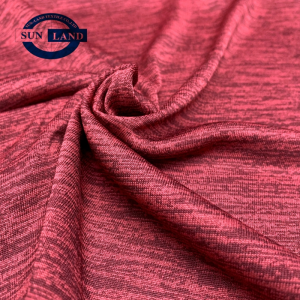Understanding Melange Fabric: A Versatile Textile Choice
Melange fabric, a unique and visually appealing material, has gained significant popularity in the textile industry. Its distinctive heathered look, created by blending different colored fibers before spinning, sets it apart from solid-dyed fabrics. This introductory look at `melange textile` will explore its characteristics, applications, and why it continues to be a favored choice for designers and consumers alike, especially when considering options like the innovative PY045, a blend of polyester and spandex perfect for active lifestyles.
What Exactly is Melange Fabric?
The term 'melange' originates from the French word meaning 'mixture'. True to its name, `melange fabric` is produced by combining at least two, sometimes more, different colored fibers. These fibers, which can be natural like cotton or wool, or synthetic like polyester and rayon, are intimately blended during the manufacturing process before they are spun into yarn. This pre-spinning blending is crucial as it imparts the fabric with its characteristic mottled or speckled appearance, offering a subtle depth and texture that plain dyes cannot achieve. The result is a `soft melange fabric` that is not only aesthetically pleasing but often possesses a softer hand-feel due to the varied fiber composition. Understanding these nuances helps in appreciating the wide array of `melange fabric designs` available in the market.
Exploring Melange Fabric Types and Their Unique Properties
There are numerous `melange fabric types`, each suited for different applications. Cotton melange is a popular choice for casual wear and t-shirts due to its breathability and comfort. Polyester melange, often blended with spandex like the PY045 material, is highly sought after for activewear because of its durability, stretch, and moisture-wicking properties. Wool melange offers warmth and a sophisticated look, making it ideal for sweaters and suiting. The specific blend of fibers and the dyeing techniques used can result in a vast spectrum of colors and textural effects. For instance, the PY045 features a dynamic mesh structure in a vibrant red with black undertones, showcasing a textured grid-like pattern that enhances breathability and visual appeal, making it a prime example of `melange fabric for activewear`. The versatility in available `melange fabric designs` allows for its use across various fashion segments.
The Manufacturing Journey: From Fibers to Fabric
The creation of melange fabric is a meticulous process primarily overseen by specialized `melange fabric manufacturers`. It begins with the careful selection and dyeing of different fiber lots. Unlike piece dyeing (where the fabric is dyed after weaving or knitting) or yarn dyeing (where yarns are dyed before fabric construction), melange involves dyeing the fibers themselves. These dyed fibers are then carded and combed together to create a thoroughly blended sliver, which is subsequently spun into melange yarn. This yarn, carrying the signature mixed-color effect, is then woven or knitted into the final fabric. The complexity lies in achieving consistent color and blend, a hallmark of reputable `melange fabric manufacturers`. This process ensures that the color is inherent to the yarn, leading to excellent colorfastness.
Diverse Applications: Where Melange Shines
Melange fabric's unique aesthetic and functional properties make it suitable for a wide range of applications. It's a staple in casual wear, lending a relaxed yet stylish look to t-shirts, hoodies, and loungewear. Its ability to mask minor stains and pilling also contributes to its practicality. One of the most significant areas is `melange fabric for activewear`. The blend of performance fibers like polyester and spandex, as seen in the PY045, offers stretch, moisture management, and breathability, crucial for athletic apparel. The subtle texture of `melange textile` also adds a fashionable edge to workout gear. Furthermore, `melange fabric for summer wear` is gaining traction, especially lighter cotton or viscose blends that provide comfort and style in warmer weather. The PY045, with its textured grid-like pattern enhancing breathability, is even suitable for innovative outerwear concepts.
Melange in Modern Fashion: Trends and Designs
`Fashion trends melange` continues to evolve, with designers consistently finding new ways to incorporate this versatile material. From high-fashion runways to everyday apparel, melange fabric adds a touch of understated elegance and visual interest. The subtle texture and depth of color it provides make it an excellent base for various `melange fabric designs`, including prints and embellishments. Its adaptability means it can be used for minimalist styles or more elaborate creations. The PY045, for example, with its vibrant red and subtle black undertones offers a contemporary, sport-luxe aesthetic which is very much in line with current fashion trends. The growing consumer demand for comfortable, stylish, and durable clothing ensures that `soft melange fabric` options will remain prominent.
Sourcing Quality: Finding the Right Melange Fabric Suppliers
For designers and apparel brands, finding reliable `melange fabric suppliers` is crucial to ensuring the quality and consistency of their final products. Reputable suppliers offer a wide range of melange fabrics, from basic cotton blends to high-performance synthetics. They can provide detailed information on fiber content, weight, and performance characteristics. Companies like Sun Land Textile, known for their craftsmanship in materials like the PY045, exemplify the innovation that `melange fabric suppliers` can bring to the market. When sourcing, it's important to consider factors like minimum order quantities, lead times, and the supplier's commitment to sustainable and ethical manufacturing practices.
Conclusion: The Enduring Appeal of Melange Fabric
In conclusion, `melange fabric` offers a compelling combination of aesthetic appeal, comfort, and versatility. Its unique manufacturing process results in a distinctive look that has found its place across various segments of the fashion and textile industry. From cozy casuals to high-performance `melange fabric for activewear` and stylish `melange fabric for summer wear`, its applications are vast. As `fashion trends melange` continue to highlight textured and depth-rich materials, and as `melange fabric manufacturers` innovate with new blends and designs, the popularity of this remarkable textile is set to endure, providing consumers with stylish, comfortable, and durable clothing options.


